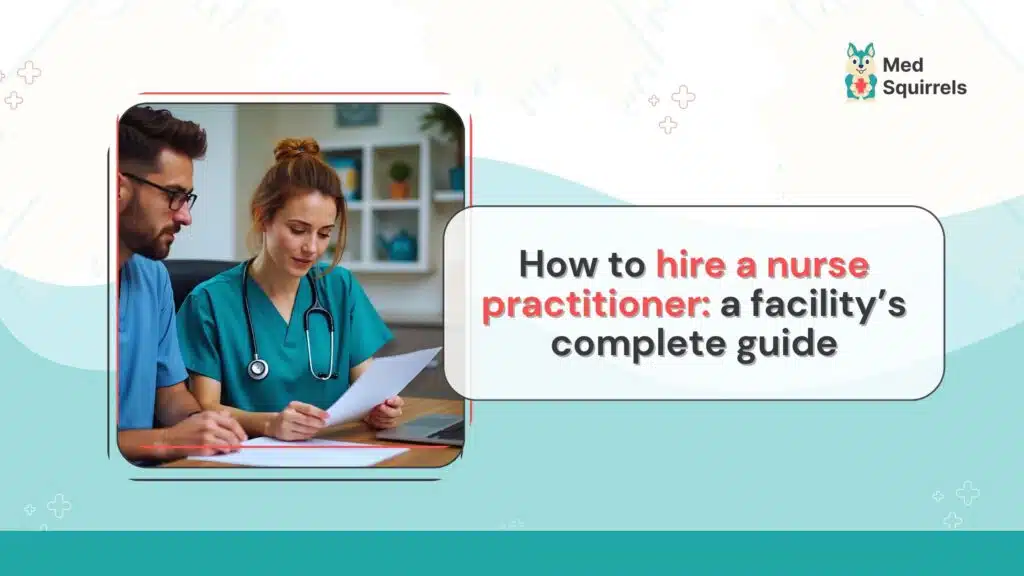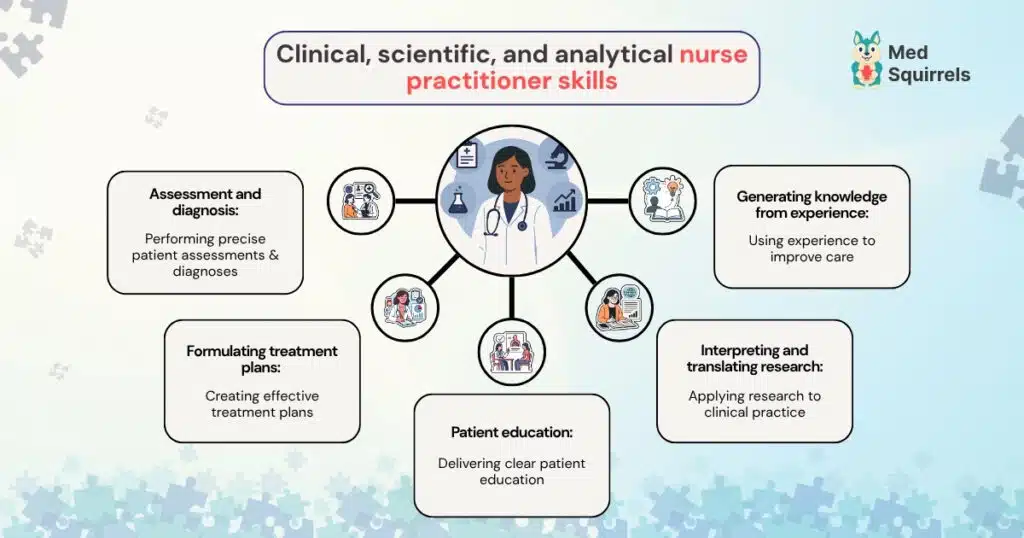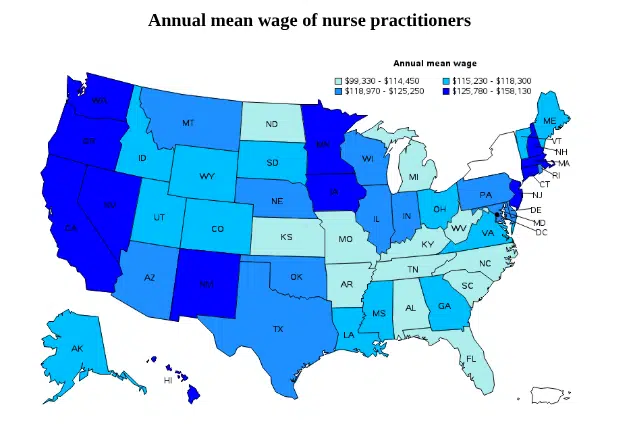How to hire a nurse practitioner: complete facility Guide

Nurse practitioners (NPs) have become essential to modern healthcare facilities. They deliver high-quality care, expanding patient access, and helping manage growing physician shortages. With their advanced skills, certifications, and clinical experience, NPs play an essential role in ensuring operational efficiency and patient satisfaction.
For healthcare recruiters, understanding how to hire a nurse practitioner strategically can transform both staffing care outcomes and staffing stability.
This blog explains every key step from understanding nurse practitioner specialties and credentialing requirements to compensation strategies. It will also highlight retention best practices, so your facility can hire, onboard, and retain top NP talent.
Understanding the NP scope of practice and specialties
Before you start the process to hire a nurse practitioner, make sure you understand every step of the staffing process. Moreover, verifying credentials and certifications is the most important part of the process. You must also know the role and responsibilities of NPs.
You should also know the different nurse practitioners, their scope of practice, and their specialties. Each specialty requires unique skills and expertise. So, as a recruiter, you must know the staffing process from application to final placement. Knowing the complete process helps you match the right NP to your facility’s needs.
Evaluating patient demographics and service gaps helps determine which NP specialties are most crucial. Considering factors like patient volume, acuity, and care complexity ensures you select the right mix of NPs.
Planning for future care trends and anticipated healthcare needs ensures your facility remains responsive and staffed with certified personnel for evolving demands.
Different certified and specialized NPs address distinct patient care needs and settings, as explained below.
Family nurse practitioners
These family nurse practitioners deliver comprehensive care to patients across all age groups. They are especially valuable in primary care and rural settings where physician shortages are common.
Their broad skills and patient-centered approach improve continuity of care and outcomes.
They often serve as the first point of contact for patients, managing both acute and chronic conditions. FNPs collaborate closely with other healthcare providers to ensure coordinated care.
Hiring family nurse practitioners helps facilities meet community health needs efficiently while maintaining high-quality care.
For example, an FNP in a rural clinic might manage routine check-ups, chronic disease care, and coordinate telehealth visits, ensuring patients receive comprehensive care even with limited local physicians.
Psychiatric nurse practitioners
Psychiatric mental health nurse practitioners specialize in behavioral health, providing therapy, medication management, and crisis intervention. As mental health demand rises, hiring NPs in this field ensures patients receive timely, specialized support.
They also help reduce the burden on primary care providers by managing complex psychiatric cases. Integrating these NPs into your care teams enhances patient outcomes and supports a more comprehensive mental health strategy.
For example, a psychiatric NP in a community clinic might treat patients with depression and anxiety while coordinating care with primary physicians, improving both access and outcomes.
Acute care nurse practitioners
Acute care NPs focus on critical and hospitalized patients, collaborating closely with physicians and other specialists. They have certifications in advanced life support and acute management.
This process makes them indispensable in high-pressure environments. They quickly respond to changes in patient conditions and help implement complex care plans.
Including skilled NPs in your team ensures timely interventions and smoother care coordination. When wondering how to hire nurse practitioners, you must align your strategy with the appropriate job requirements.
These specialties ensure both operational efficiency and improved patient outcomes.
For example, an acute care NP in a hospital ICU might stabilize patients after surgery while coordinating with multiple specialists, ensuring rapid, effective treatment.

Credentialing and state laws requirements
Credentialing is a key phase in the staffing process, especially for nurse roles and other healthcare positions. It ensures compliance, quality care, and makes nurse staffing more efficient and reliable.
Proper verification ensures compliance and quality care, making nurse staffing solutions more efficient and reliable. Verifying a candidate’s education ensures they meet the required standards.
Checking clinical experience confirms they can handle the responsibilities of the role. Reviewing certifications guarantees compliance and supports consistent, high-quality care delivery.
Understanding nurse practitioner credentialing requirements early prevents costly onboarding delays. It also helps facilities maintain accreditation and meet payor standards efficiently.
Staying informed about state-specific licensing regulations is essential for every healthcare facility. It ensures that NPs can begin practicing legally and effectively from day one.
Completing credentialing thoroughly reduces the risk of errors or delays in patient care. Clear documentation and verification also give hiring managers confidence in each candidate’s qualifications.
Let’s check out some of the credentialing essentials:
- Verify graduate education and national board certification.
- Confirm malpractice history and malpractice insurance for nurse practitioners.
- Check previous employment and peer references.
State licensing considerations
Each state has different regulations defining the nurse practitioner’s scope of practice and prescribing authority. Facilities must stay informed about these variations to ensure compliance and streamline approvals.
Recruiters must also check and stay aware of current employment laws and state-specific hiring regulations to avoid legal complications during onboarding.
Staying proactive about licensing changes also reduces delays in getting NPs onboarded. Additionally, understanding state rules ensures that your facility maintains consistent care quality and avoids potential fines or legal issues.
Salary ranges and competitive pay strategies
Understanding the nurse practitioner salary range is essential for fixing compensation packages that attract and retain top talent. The U.S. nurse practitioner pay rates vary by specialty, region, and experience level.
When planning how to hire nurse practitioners, researching market trends and providing similar salaries in the facilities ensures your offers remain competitive.
Facilities that align salaries with relevant skills, certifications, and experience can improve recruitment success and increase the likelihood of hiring highly qualified NPs. Clear communication of pay structures and benefits helps candidates understand the total value of the role.
Recruiting nurse practitioners comes with many challenges. These challenges include limited candidate availability and the need to match specialized skills with facility needs. Recognizing these challenges highlights the importance of thorough planning and strategic recruitment to secure the best talent.
Offering transparent and fair compensation also strengthens trust and long-term engagement with your nursing staff.
Current pay insights
According to recent BLS data, NPs typically earn $132,050 per year, while Acute Care and Psychiatric NPs may demand higher salaries due to specialization.
Regional differences also play a significant role in pay expectations. Evaluating competitor compensation helps your facility stay attractive to experienced candidates. A successful compensation strategy includes more than base salaries.
Consider:
- Sign-on bonuses and relocation support
- Professional development funds for certifications
- Performance-based incentives
Offering transparent pay structures and flexible working hours not only attracts top candidates but also positions your facility as a preferred employer. When you hire nurse practitioners, clarity around compensation builds trust and long-term engagement.
While you want to hire a skilled nurse practitioner for your facility, it is essential to be aware of details related to salaries across the state. The infographic has added clear guidance on salary ranges for better understanding.

Source: www.bls.gov
Retention tips and effective scheduling models
If your facility has flexible policies for retaining employees, you can follow the retention process if the candidates agree to stay. Instead of searching for a new professional, hiring someone already familiar with your facility’s work culture can be more fruitful.
Retaining experienced staff reduces onboarding time and ensures smoother integration with existing teams. This approach also helps maintain continuity of care and strengthens team cohesion.
Once you hire a nurse practitioner, keeping them engaged is just as important. Before recruiting, it is essential to check for the required certifications to ensure candidates meet facility and state standards.
NPs value autonomy, career growth, and a healthy work-life balance. Facilities that provide supportive and employee-friendly environments reduce turnover and improve patient satisfaction.
Offering clear career growth paths and recognizing accomplishments keep NPs motivated. Regular feedback and performance discussions help address concerns early.
Investing in resources that make daily workflows easier also enhances satisfaction and lowers stress.
Here are a few best practices for NP retention:
- Encourage ongoing training and professional mentorship
- Use flexible scheduling models, such as telehealth or shared shifts
- Recognize contributions and involve NPs in decision-making
Scheduling systems that respect personal time and reduce burnout directly enhance retention. Promoting open communication and clinical independence fosters a positive workplace culture and long-term loyalty.
Choosing the right nurse practitioner staffing model
Choosing between contractual and full-time staffing affects both flexibility and long-term team stability. Contractual staffing offers the ability to quickly scale up or down based on patient volume and seasonal demands.
Full-time staffing ensures continuity of care and fosters stronger relationships between NPs, patients, and the care team. Before hiring, recruiters must know how to craft a detailed healthcare job description to outline responsibilities, required skills, and expectations clearly.
A well-prepared job description is crucial as it guides the hiring process, attracts qualified candidates, and sets clear expectations from the start. Understanding your facility’s patient demographics, service needs, and growth plans is key to deciding the right mix.
Facilities can also evaluate cost implications, such as benefits, training, and onboarding expenses, when weighing staffing options. By strategically combining contractual and full-time models, healthcare organizations can maintain high-quality care while managing budgets effectively.
Contractual role staffing benefits
Contractual staffing allows facilities to address fluctuating patient volumes or unexpected staff absences quickly. Partnering with an experienced nurse practitioner staffing service ensures access to a pool of qualified candidates ready to step in when needed.
Contractual staffing also gives facilities the flexibility to evaluate NP performance before committing to full-time roles. It helps manage budgets effectively while maintaining consistent patient care during high-demand periods.
Full-time role staffing advantages
Full-time hires help build consistent care teams, improve patient trust, and reduce long-term costs. They also allow you to review resumes, verify skills and certifications, and ensure strong cultural and professional alignment before making a staffing decision.
This staffing model also supports continuity of care and strengthens relationships between NPs, patients, and the care team. It provides opportunities for ongoing professional development and long-term retention within your facility.
Strategic hybrid approach
Many healthcare facilities combine both staffing models for maximum flexibility. Using reliable nurse practitioner recruitment services lets you hire a nurse practitioner either temporarily or full-time, adapting to patient volume, budget, and operational priorities.
A strategic hybrid approach also allows facilities to balance short-term coverage with long-term team stability. It ensures that patient care remains uninterrupted while optimizing staffing costs and efficiency.
Partnering with modern staffing solutions for quick and cost-effective NP hiring
When healthcare facilities face a patient surge or aim to improve outcomes, they often decide to hire a nurse practitioner to strengthen their care teams. Before recruiting, administrators must evaluate key details. They need to decide whether to hire a full-time professional or a contractual NP. They also must check the required certifications, skills, and credentials.
This careful research ensures compliance, quality, and long-term success. Many recruiters start with internal references, university partnerships, or free job portals.
While these methods sometimes yield results, they often have limited reach and delayed responses. They can also lead to inconsistent candidate quality, making it harder to fill critical roles on time.
Traditional staffing agencies, though familiar, can also bring challenges. The challenges include high service fees and limited transparency in candidate screening. These traditional agencies also have slower turnaround times and poor alignment with specialized nurse practitioner job requirements.
After experiencing these hurdles, many healthcare leaders are now turning to modern, AI-powered staffing platforms like MedSquirrels. These staffing platforms are dedicated exclusively to healthcare staffing.
MedSquirrels offers nationwide services and cost-effective staffing plans designed for facilities to meet varying needs.
Choose the plan that fits your staffing approach and requirements:
Orange plan:
Select this plan if you want MedSquirrels to find a contract clinician or non-clinician for you and manage their HR/payroll. In 2-5 business days, you will receive curated profiles of top talent. Our platform will manage interviews, offer letter generation and negotiation, credentialing, onboarding, payroll, and benefits administration.
Purple plan:
Use this plan when you source the clinician or non-clinician directly and need a full employer-of-record (EOR) and payrolling solution. MedSquirrels will handle offer letter negotiation, credentialing and onboarding, payroll and benefits administration, compliance, and timekeeping, while the provider works from your facility.
Blue plan:
Use this recruitment-focused option for full-time hires. MedSquirrels sources and screens candidates based on your job and manages interviews, contract generation, and negotiation.
By using AI-driven tools and a healthcare-focused approach, MedSquirrels reduces hiring time and minimizes administrative burden. This staffing platform connects facilities with certified, pre-vetted nurse practitioners ready to make an impact.
Our staffing platform empowers healthcare facilities to streamline nurse practitioner recruitment. As a recruiter, you can maintain compliance and ultimately deliver better patient care. Get a free demo and see how MedSquirrels can transform your healthcare hiring process.
Apart from assisting facilities in fulfilling their staffing needs, MedSquirrels also connects healthcare professionals with top job opportunities at leading facilities nationwide. They can explore open jobs and apply for those that align with their professional goals.
FAQs
How do I determine which NP specialty my facility needs?
Evaluate patient demographics, care gaps, and anticipated growth areas. For example, family NPs suit primary care, psychiatric NPs address behavioral health, and acute care NPs work in hospital or critical care settings.
What are the key steps in NP credentialing and licensing?
Verify education, certifications, work history, and state licensure. Partnering with credentialing agencies can streamline verification and help ensure compliance with state-specific requirements.
What should I include in an NP job description?
Clearly define responsibilities, required certifications, scope of practice, expected patient load, and work schedule. A detailed job description ensures the right candidates apply and sets clear expectations.
Is MedSquirrels cost-effective compared to traditional staffing agencies?
Yes. MedSquirrels is cost-effective compared to traditional staffing agencies. This modern staffing platform provides affordable, transparent staffing solutions without compromising candidate quality or compliance, saving both time and money.
Can I hire both full-time and contractual NPs through MedSquirrels?
Yes. MedSquirrels supports affordable staffing strategies, allowing you to hire full-time or contract NPs based on facility needs and patient volume.
Suresh writes for MedSquirrels about healthcare staffing, career tips, and industry updates. He is passionate about helping professionals and facilities navigate hiring challenges.
